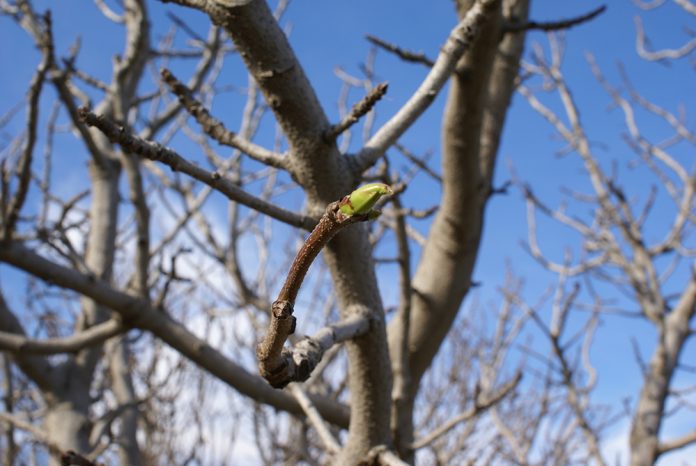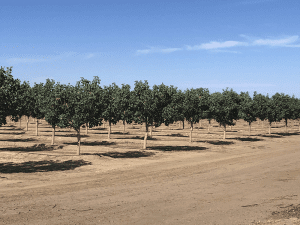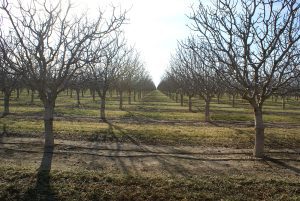
The prospect of less chill accumulation during dormancy is becoming a concern of pistachio growers, particularly in warmer growing regions in California.
Pistachio trees require a cumulative amount of chilling to exit dormancy in the spring.
UCCE Farm Advisor Elizabeth Fichtner explained that the chilling requirement is a physiological mechanism that protects buds from the winter cold. In the absence of adequate chill, budbreak could occur earlier and leave buds, flowers and new shoots exposed to cold conditions.
In addition, lack of adequate chill during dormancy may delay bud break or result in irregular bud break, leaving multiple stages of fruit growth on trees. Flower morphology can be affected and fruit set reduced. Pollination rate may be reduced due to asynchronous bloom of male and female trees. Lower fruit set is also associated with an increase blank nut percentage, decrease in split percentage and uneven maturation.
Fichtner noted in the UC publication San Joaquin Valley Trees and Vines that studies conducted by UC scientists determined that Peters males have a higher chilling requirement than their ‘Kerman’ female counterpart. Peters males require at least 900 hours below 45 degrees C to achieve 50% bloom. The Kerman female requires 700 hours below 45 degrees C to achieve 44% bloom (Ferguson et al. 2002). The chilling requirements for newer varieties such as Golden Hills and Lost Hills have yet to be assessed.
Facilitate Uniform Bud Break
With the 2021 California registration of Dormex, a synthesized hydrogen cyanamide product, pistachio growers gained access to a new tool to facilitate uniform bud break as pistachio trees came out of dormancy. Almonds are also on the label. Alzchem GmbH, the manufacturer of Dormex, has an EPA approval for application in walnuts, but state registration is pending.
Already in use in grape vineyards and cherry tree orchards, Dormex was used to trigger bud break in pistachio and almond orchards starting in 2022.
Alzchem representative John Meyer explained that a single Dormex application 30 days prior to estimated bud break stimulates a pathway to turn tree carbohydrates into glucose. When winter chill in orchards has been inadequate, he said Dormex helps achieve a more uniform bud break. It cannot overcome inadequate tree carbohydrate reserves and other management issues.
UCCE Pomology Specialist Louise Ferguson said Dormex could help growers avoid second and third shakes at harvest caused by uneven maturity of pistachio crops. There is also better synchronization of male and female trees.
“It precipitates an earlier and stronger bloom,” Ferguson said. She noted that she was involved in use of a hydrogen cyanamide product in Australia 25 years ago. She said it reliably brought bud break in mature trees two to three weeks earlier with a compacted bloom.
How It Works
Spray applications of Dormex are absorbed by buds and twigs, initiating bud development by interacting with the catalase enzyme. After applications, at the expected bud break time for the trees, flower and leaf buds break at the same time. The number of lateral buds can be increased, improving yield potential. Low chill winters typically result in trees that exhibit predominantly terminal bud breaks that give a ‘poodle tail’ appearance to the trees.
By activating buds that would otherwise remain dormant or be slow to emerge, the pollination potential is increased. This can lead to a more uniformly mature crop at harvest. It also can help even out the impact of alternate bearing crops.
Grape and cherry growers are more familiar with the use of Dormex on their crops, Meyer said, and have experienced earlier harvests after use. If they have diversified into almonds and pistachios, he said those growers are more likely to use the product based on their experience.
Worker Safety Demands
Justin Nay, PCA with Integral Ag, confirmed that cherry growers use the product and pistachio growers have been asking him about its efficacy. They have voiced concerns about application safety requirements, he said, because it is labeled with a danger signal word.
Ferguson said she believes that worker safety concerns were keeping pistachio growers from adopting the use of Dormex.
Meyer acknowledged the safety requirements for Dormex as a restricted use product. Since the product is an eye and skin irritant, the label requires full personal protection equipment (PPE), including a NIOSH respirator, and a certified applicator along with other protocols for use. It has a closed-system fill requirement to minimize exposure. But recent EPA-approved labels also have included a shorter re-entry window and smaller setbacks.
A recent report EPA noted high toxicity to aquatic life and an incident where a spray application made in adverse weather conditions resulted in defoliation of a nearby lemon grove.
The report also noted it is not persistent in soil or water and degrades into plant nutrients including urea. Meyer said the Dormex breaks down quickly after application into urea and Dicydianamide (DCD). DCD is a nitrification inhibitor which, combined with urea, creates a stabilized or slow-release nitrogen source within the plant.
In spite of worker safety demands, Meyer said he believes pistachio growers will find the benefits of using Dormex in their orchards will outweigh the extra precautions. Although the PPE requirements are restrictive, application is not difficult. A single application of Dormex by ground rig in pistachios and almonds at a rate of 4 gallons per acre is required.
Under proper application conditions, Dormex is absorbed quickly into the twigs and buds and is rain-fast in as little as four hours.
Timing of application is 30 days or more prior to anticipated bud break of the earliest variety. Meyer said it is important that a non-ionic surfactant be used to carry the product and ensure good coverage. If oil has been applied, it will prevent the proper absorption of Dormex.

For safety, Alzchem adds a bright blue dye into the Dormex formulation, making it easier to see, so spills, leaks in the spray system or product residue are evident immediately. Meyer also stressed that Alzchem adds a unique dual-stabilizer technology to improve the quality, storage and handling of the product.
There are some warnings about application timing. If Dormex is applied less than four weeks prior to natural bud break, yields may be reduced. Take proper precautions to prevent spray drift onto non-target crops.
Low-vigor or low-capacity trees should receive applications earlier than 30 days prior to anticipated normal bud break. Some yellowing may occur on the first leaves, but the developing growth will be normal.
Dormex is not a cure-all. Growers still need to manage tree health and irrigations. But with increasingly warmer winters, Dormex does appear to be a potential yield-enhancing tool to help pistachio growers manage crops more effectively.











